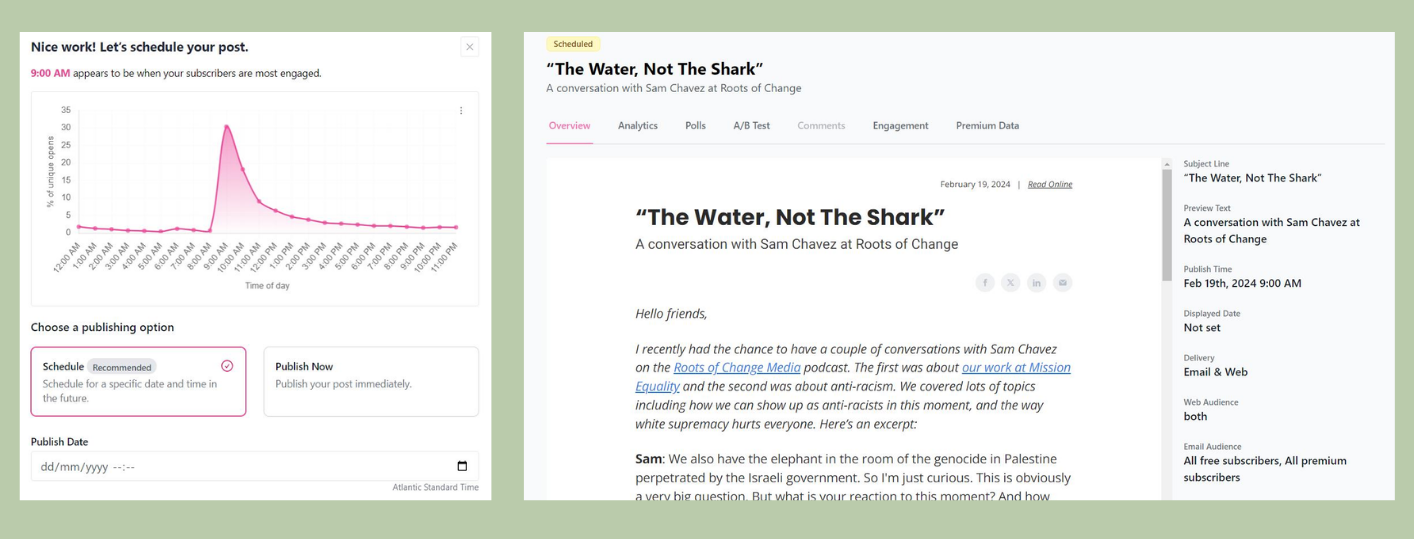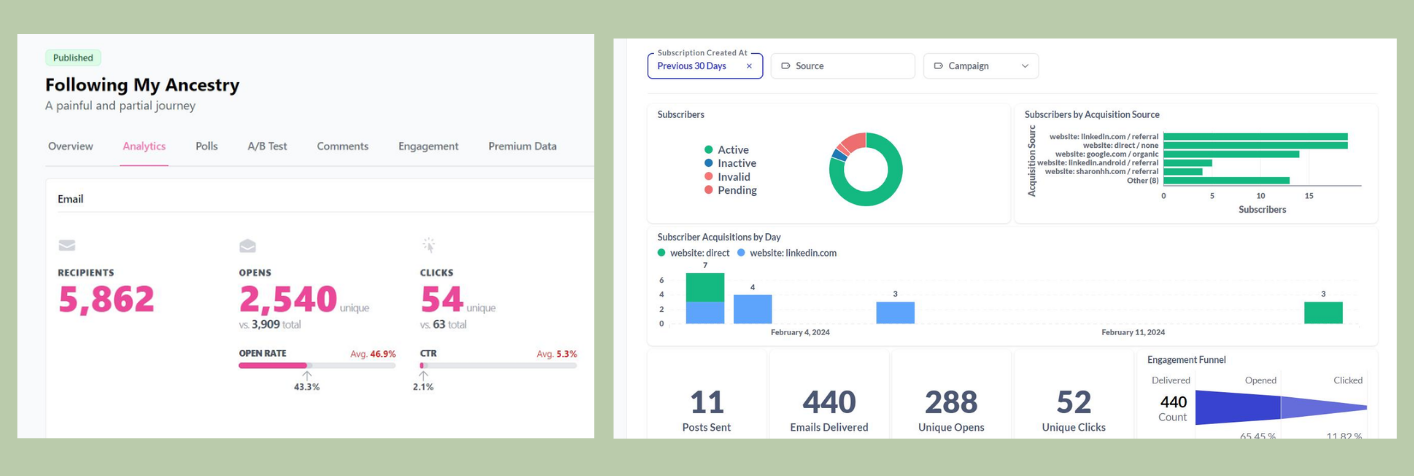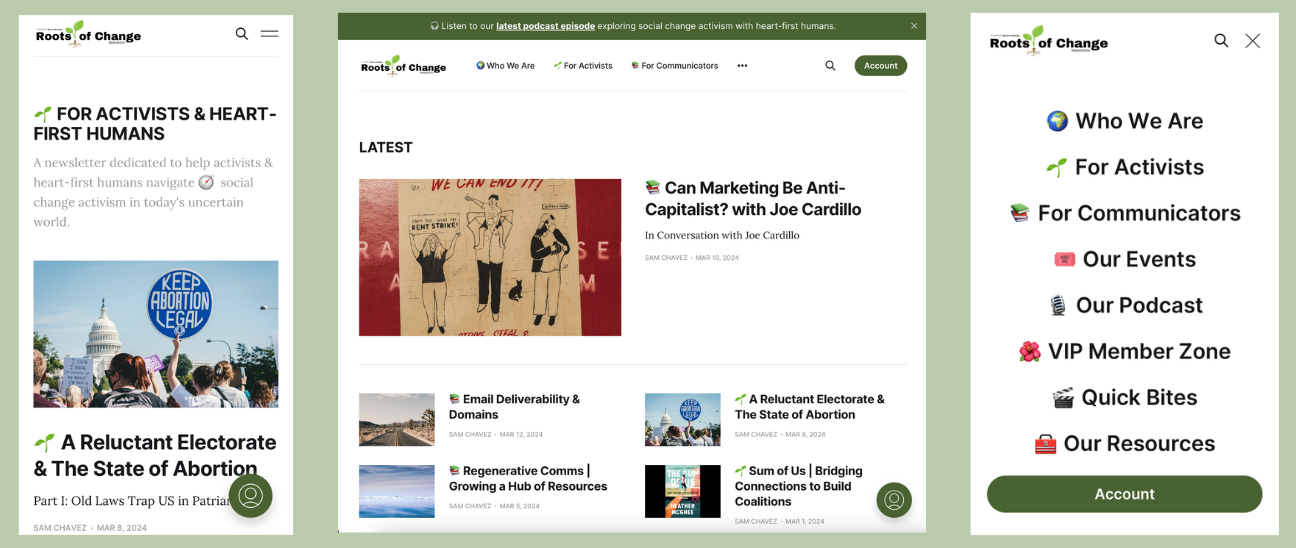
🌺 Evaluating Beehiiv & Ghost Newsletter Platforms
Analyzing Beehiiv and Ghost email publishing platforms
Table of Contents
Why We Left Substack
The short answer is: because Nazis. We didn’t want our newsletter income being used to promote and platform Nazis, and we were pretty sure our subscribers wouldn’t want that either, so it was a no-brainer.
When Substack began platforming Nazis, we spoke out with fellow writers in a joint letter to the Substack CEOs. After a lackluster response, we knew we didn’t want to support tech that actively harms our movements.
The easy decision was to leave Substack, but deciding where to go wasn’t as simple. We spent a lot of time discussing the options, their capabilities, the features, and the expertise needed for each. We searched for alternatives that offered more freedom and flexibility in our communications, reach, and data. And it was important to find a solution that would align with our values and lend itself to a solidarity economy. And we ultimately chose different platforms — Sam chose Ghost and Sharon beehiiv. Here, we discuss the reasons for our choice, and how the platforms stack up so far.
Why Sharon Chose beehiiv
I’d looked at beehiiv (aff) before because a publication I respect had moved there in 2022. I’m internet old and have seen many platforms come and go, so I decided to get their take on the move and the platform well before I was thinking about moving.
I was sold on some of the backend functionality even then, but when crunch time came, and I urgently needed an alternative to Substack, there were three considerations that really mattered:
- Where did the founders stand on platforming and profiting from Nazis? One of the originators of the Substackers Against Nazis movement arranged talks with the founders of both beehiiv and Buttondown. In both cases the founders were unequivocal: no Nazis. While I know that for some values can be fluid, that was good enough for me on this issue.
- How would the transition affect existing subscribers? Beehiiv’s co-founder put me in touch with one of their top tech people and he answered all my questions and provided an in-depth guide to the transition process, specific to moving from Substack. This worked smoothly when the time came, with only one subscriber having an issue on the day I moved everything over. And that was pretty easy to resolve.
- Could I afford it? I’d also looked into Ghost for many of the reasons Sam outlines, but financially it was too much of a stretch. I knew I would need the concierge service, which meant a large initial outlay. In the end, Beehiiv was a good option because even with the monthly cost, I ended up better off financially without losing the 10% Substack had been taking. (Check out the relative costs on this Buttondown comparison tool.)
What’s better on beehiiv?
From my perspective, most things are better. Yes, beehiiv took a little bit of tweaking, but their help files and videos are excellent, and the people in their Slack space are super quick to help with any issues, AND to let you know when you need to approach support. For me, that’s an improvement over how Substack was towards the end, though I suspect I was being ignored because I’d talked about racism and bigotry on Notes (and was vocal about what didn’t work).
Digging into the detail, beehiiv is great on editing and publishing options. I especially love that you can alter the visibility for different blocks of content within a post, so it can be seen by free or paid, email or web.

And though there are only a few layout options, the ability to change individual color and visual settings is a winner in my book.
There’s also A/B testing for titles, the ability to have different titles and descriptions for email and web, SEO options including editable URLs (definitely do this), content tags which can be used as menu items, editable footers, the ability to include custom headers and much, much more.
Since I’m paying $99 a month for my plan, I also get access to other cool stuff. Beehiiv’s email stats blows Substack out of the water - enough charts to gladden a nerdy girl’s heart on opens, emails, and much more.
Like Substack there are reports on each email sent as well as a monthly report, but there are also many ways to see your subscriber and email data.

Beehiiv includes automations, so you can run a welcome sequence for new subscribers (Substack didn’t have that), segmentation so you can see data on subsets of subscribers AND email those subsets separately, as well as a referral programme where you can build in your own incentives. Plus there are ways to monetize and promote your newsletter built right into the platform.
What’s worse on beehiiv?
“Worse” is a relative term here, as it depends what you’re looking for. Beehiiv has no social network like Substack’s Notes, and I don’t miss that at all, given the racist and bigoted trolling I experienced there.
Its recommendations capability exists but is less straightforward to implement than on Substack.
Creating pages and adding them to menus seems rather clunky, though once it’s done it looks good.
Overall, there are things that aren’t quite “finished” reflecting the fact that it’s a newer platform, but the founders say feature parity is coming, and they are rolling out new features fast.
Who’s Beehiiv for?
There are lots of answers to this question. If you want to build a large list but don’t need or want to make money from it, and don’t want to spend money on it, you can’t beat the free audience size available on beehiiv. At 2500, it’s more generous than most email marketing platforms, though you’ll get more basic stats and no monetization options.
If you’re not particularly techie, it’s also a good fit - most people can launch a newsletter from scratch in just a few minutes (a bit easier than transferring an existing publication.)
If you want ultimate customization, then it’s probably not for you, and it’s definitely not open source, so if that matters, then you’re better off with Ghost, which remains my backup if I need to change platforms again.
Overall, I’m confident I made the right decision for my current circumstances. I’m loving beehiiv and hope I won’t need to move any time soon.
Why Sam Chose Ghost

As I’ve watched Substack’s questionable business practices pile up and other tech companies continue to choose profit over social wellbeing, it has become increasingly important for me to have ownership and flexibility over my content, data, and how I can communicate with my audience.
That’s why Ghost was the “North Star” platform for The Roots of Change newsletters and content. Ghost is an independent publishing platform. They are an open-source platform that does not take a cut of creators' profits (aka 0% fees! aka more money directly to creators).
Ghost has been on my radar for at least a year, but I was concerned with the amount of technical expertise required to build a publication or newsletter there. By the time the Substack CEO responded to our joint letter, I felt Ghost had made significant improvements for my moderate coding ability to feel comfortable with the platform.
- Segmentation & User Experience: Previously, I managed two newsletters across two platforms: Substack for activists and Mailchimp for communicators. A combined alternative needed a CRM with robust data infrastructure, data flows, and segmentation capabilities, while also supporting our organizational values.
- Ease of Discovery & Reach: One of the benefits of platforms like Substack is the dedicated audience of readers who can more easily discover your content. As social media has fragmented, Substack was my main driver for new sign-ups. Leaving Substack was a risk, as it meant I might not grow as quickly and would cause additional work to promote my newsletters.
- Cross-Platform Analytics: The closed-loop nature of Substack’s platform gave me a limited view of my overall digital performance. I wanted to clean up my tech stack to evaluate cross-channel journeys.
What’s better on Ghost?
Ghost has proven to be a breath of fresh air away from the platforms and their limitations. I wanted to create an experience that allowed for customization so each person could receive the type and amount of content they prefer when subscribing. I’ve found Ghost to be one of the better platforms for subscriber customizations. Ghost’s use of profiles and logins helps us align with our organizational values to meet folks where they are.

We’ve also seen a noticeable improvement in our email deliverability, open rate, and click rate across both audiences since migrating to Ghost and authenticating. Even without Substack’s discovery tools, our list size grew by 39% in the first three months on Ghost. A lighter tech stack allowed for more flexibility and cross-platform promotion.
What’s worse on Ghost?
There are still some typically easy features that are not yet available or require a little extra coding to add. One of the features that could be improved is the analytics. I’ve found their post-specific analytics are great for a granular analysis to understand the types of content that is working, but not their overall analytics. It can be difficult to understand delivery and unsubscribe rates in the current platform as well as performance by segments.
I also hope to see improvements in their CRM and ability to easily tag and segment audiences. Currently, I have outsourced my tagging to Zapier so that my list can be segmented and I can deliver relevant content, but I would prefer to see those features directly in Ghost. While these features are not yet here, I have hope that they will be coming and the dashboard and capabilities will continue to improve.
Who’s Ghost for?
Ghost is great for anyone looking for independence from tech platforms and the Platform Era including publishers, content creators, organizers, entrepreneurs, and organizations. Ghost also powers some of the top media companies and brands like The Atlantic, Buffer, and Kickstarter. While Ghost has made improvements, there are still a few features that require a more technical understanding. I wholeheartedly recommend Ghost for anyone with at least some high-level coding skills for now, but also think it’s a great platform for anyone. I for one happily embrace the few improvements that need to be made if it means I can build my media company and agency on technology that treats social wellbeing as a part of its mission.
Thank you for reading! Check out and support Sharon’s Anti-Racism newsletter.
For more on The Roots of Change Media’s transition to Ghost, download our ‘Building An Independent Tech Stack Case Study’
🌱 the roots of change newsletter 📚 Newsletter
Join the newsletter to receive the latest updates in your inbox.







